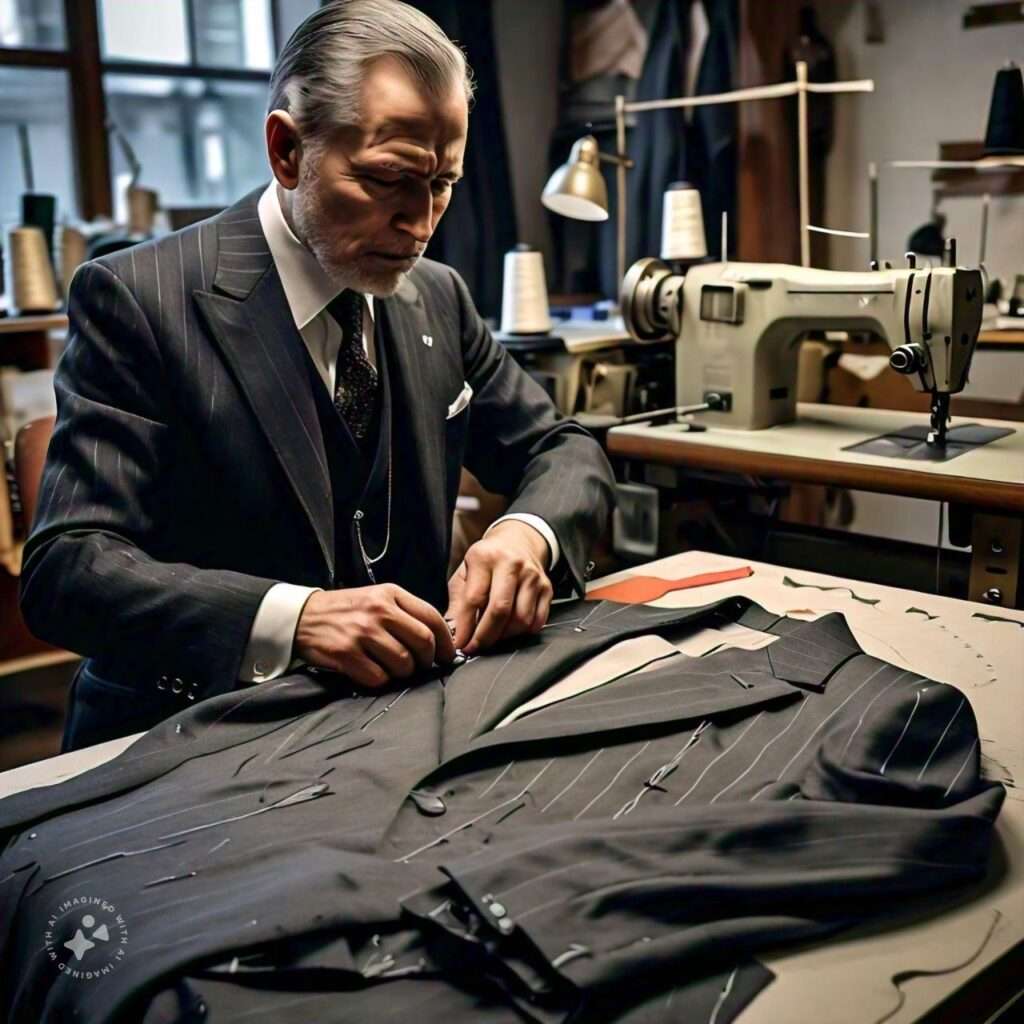Here’s a comparison between ready-to-wear and bespoke suits :
Ready-to-wear:
- Affordable and available in standard sizes and colors
- Made in factories with mass production techniques
- Limited control over fit, fabric, and details
- Can be altered to fit, but limitations apply
- Generally, the least expensive option
Bespoke:
- Tailored to individual measurements and style preferences
- Handmade by skilled tailors with high-quality materials
- Multiple fittings ensure a precise fit
- Offers total creative control and customization
- The most expensive option due to the personalized approach

Why bespoke suits?
Bespoke suits are a worthwhile investment for several reasons.
- Perfect fit: Bespoke suits are tailored to the individual’s precise measurements, ensuring a flawless fit that hides flaws and accentuates the wearer’s features.
- Customization: Bespoke suits allow for complete personalization, from fabric choice to details like buttons and lapels, ensuring a unique and personalized garment.
- Quality: Bespoke suits are crafted with high-quality materials and exceptional craftsmanship, resulting in a long-lasting and timeless piece.
- Heritage: Bespoke suits have a rich history, originating from London’s Savile Row, and continue to be a symbol of tradition and excellence.
- Personal experience: The bespoke process involves a personal and intimate experience with the tailor, creating a special connection and understanding of the client’s needs.
- Durability: Bespoke suits are built to last, with the potential to be worn for decades with proper care.
- Investment: While the initial cost may be high, bespoke suits can be
the client to discuss style, fabric, and budget.

Process of making a bespoke suit
1.Measurements: The tailor takes precise measurements of the client’s body.
2.Pattern creation: A unique pattern is created based on the measurements.
3.Fabric selection: The client chooses the fabric, and the tailor advises on suitability.
4.Cutting: The fabric is cut according to the pattern.
5.Sewing: The suit is sewn together by hand or machine.
6.Fittings: The client tries on the suit for adjustments.
7.Finishing: Final touches, such as buttonholes and stitching, are added.

How long it takes to make a bespoke suit?
This process can take several weeks to months, depending on the tailor’s schedule and the suit’s complexity.
What Construction material is used to make bespoke suits?
Bespoke suits are made using different materials, with the choice of material depending on the desired outcome. Here are some of the materials used in bespoke suit construction.
- Horsehair or a blend of natural fibers for the canvas layer.
- Wool, cotton, linen, cashmere, or silk for the suit fabric.
- Fusible interlining material for fused construction suits.
The choice of material also affects the construction method, with three main techniques used: full canvas, half canvas, and fused construction. Full canvas is considered the gold standard, while half canvas offers a balance between quality and affordability. Fused construction is the most budget-friendly option but may compromise on durability.

How long bespoke suits last?
Bespoke suits are highly customizable and made with high-quality materials, resulting in a long-lasting and timeless piece. They are carefully crafted and hand-stitched, making them super durable, and they can last for many years .The longevity of a bespoke suit is due to the skills of several experts involved in the process, including a cutter, tailor, trouser maker, finisher and presser
How to take care of bespoke suits?
Here are some tips for taking care of a bespoke suit :
- Use a sturdy wooden or plastic hanger to prevent the suit jacket from creasing or sagging.
- Store your suit in a breathable garment bag made of cotton or linen to protect it from dust, moisture and light.
- Organize your closet so that your suits have enough space between them to prevent wrinkles and allow for airflow.
- Avoid dry cleaning your suit too often, as the chemicals used in the process can damage the fabric.
- Spot clean stains on your suit as needed, and seek professional help for more stubborn stains.
- Steam your suit instead of using an iron, as direct heat can damage the fabric.
- Allow your suit to rest for at least 24 hours between wearings to help the fabric recover from stretching and stress.
- Alternate between suits regularly to prevent excessive stress on any single suit.

Pakistan’s Leading Personal Stylist, Wardrobe Consultant & Image Consultant
Hamid Saeed, a New York based renowned Dressing Coach, empowers individuals to unlock their confidence through tailored fashion solutions. With years of expertise in image consulting, Hamid offers personalized guidance through:
Workshops | TV Appearances | Consultations | Writing
As a Customized Wardrobe Manufacturer, Hamid helps clients create stylish, functional wardrobes reflecting their unique personality.



